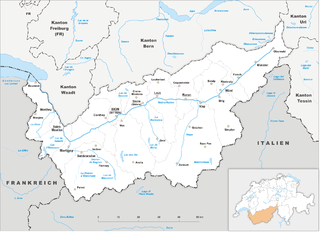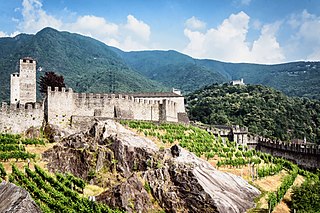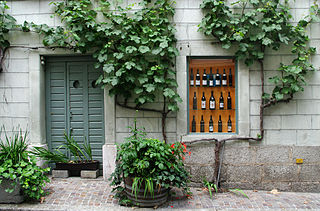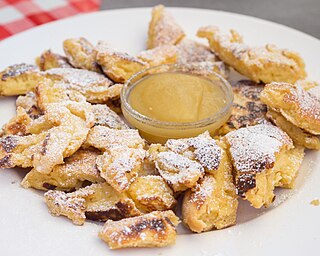
The geography of Switzerland features a mountainous and landlocked country located in Western and Central Europe. Switzerland's natural landscape is marked by its numerous lakes and mountains. It is surrounded by five countries: Austria and Liechtenstein to the east, France to the west, Italy to the south and Germany to the north. Switzerland has a maximum north–south length of 220 kilometres (140 mi) and an east–west length of about 350 kilometres (220 mi).

Ticino, sometimes Tessin, officially the Republic and Canton of Ticino or less formally the Canton of Ticino, is one of the 26 cantons forming the Swiss Confederation. It is composed of eight districts and its capital city is Bellinzona. It is also traditionally divided into the Sopraceneri and the Sottoceneri, respectively north and south of Monte Ceneri. Red and blue are the colours of its flag.

The river Ticino is the most important perennial left-bank tributary of the Po. It has given its name to the Swiss canton through which its upper portion flows.

The Grisons or Graubünden, more formally the Canton of the Grisons or the Canton of Graubünden, is one of the twenty-six cantons of Switzerland. It has eleven districts, and its capital is Chur. The German name of the canton, Graubünden, translates as the "Grey Leagues", referring to the canton's origin in three local alliances, the Three Leagues. The other native names also refer to the Grey League: Grischùn in Sutsilvan, Grischun in the other forms of Romansh, and Grigioni in Italian. Rhaetia is the Latin name for the area. The Alpine ibex is the canton's heraldic symbol.

Valais, more formally the Canton of Valais, is one of the 26 cantons forming the Swiss Confederation. It is composed of thirteen districts and its capital and largest city is Sion.

Castanea sativa, the sweet chestnut, Spanish chestnut or just chestnut, is a species of tree in the family Fagaceae, native to Southern Europe and Asia Minor, and widely cultivated throughout the temperate world. A substantial, long-lived deciduous tree, it produces an edible seed, the chestnut, which has been used in cooking since ancient times.

Swiss cuisine is an ensemble of national, regional and local dishes, consisting of the ingredients, recipes and cooking techniques developed in Switzerland or assimilated from other cultures, particularly neighboring countries. The diversity and comprehensiveness of Swiss gastronomy reflects the linguistic, cultural and geographical diversity. The climate of Switzerland allows for a large variety of terroirs, and therefore a wide range of indigenous food, from simple cereals to refined products like cheese and wine.

Röstigraben is a term used to refer to the cultural boundary between German-speaking and French-speaking parts of Switzerland, the latter known in French as the Suisse romande. There is also the term Polentagraben, referring to the boundary between German-speaking cantons, and the Italian-speaking canton of Ticino.

Ticino has a long tradition of winemaking, being the southernmost region of Switzerland. Wine has been produced there since the Roman era. The region is known for its Merlot, which was introduced in the early 20th century.

Swiss wine is produced from nearly 15,000 hectares of vineyards, and the wines are mainly produced in the west and in the south of Switzerland, in the cantons of Geneva, Neuchâtel, Ticino, Valais and Vaud. White grape varieties are grown on 43% of the country's vineyard area, and red grape varieties on 57%.

The Italian language in the Italian Switzerland or Swiss Italian is the variety of the Italian language taught in the Italian-speaking area of Switzerland. While this variety is mainly spoken in the canton of Ticino and in the southern part of Grisons, Italian is spoken natively in the whole country by about 700,000 people: Swiss Italians, Italian immigrants and Swiss citizens with Italian citizenship.

The Valle Verzasca is a valley in the Locarno district of the canton of Ticino, Switzerland. It comprises the municipalities of Mergoscia, Vogorno, Corippo, Lavertezzo, Brione, Gerra, Frasco, and Sonogno. As of 2004, the total population is 3,200. It is the most central valley of Ticino, and none of the passes out of the valley cross cantonal or national borders. The valley is formed by the river Verzasca and is situated between the Leventina and the Maggia and culminates at Pizzo Barone.

The pane ticinese is a white bread traditionally made in the Swiss canton of Ticino, but also available in the rest of Switzerland, where it is known as "Bread of Ticino". In Ticino, it is referred to by a number of names specific to the region, including pane riga, reale or lireta.

Italian immigration to Switzerland is related to the Italian diaspora in Switzerland. Italian emigration to Switzerland took place mainly from the end of the 19th century.

The cuisine of Corsica is the traditional cuisine of the island of Corsica. It is mainly based on the products of the island, and due to historical and geographical reasons, has much in common with Italian cuisine, and marginally with those of Nice and Provence.

Rheintaler Ribelmais, Rheintaler Ribel or Türggenribel is a ground product that is made from a traditional type of maize grown in the Swiss Rhine Valley and Liechtenstein. Since summer 2000, Rheintaler Ribel AOP has been the only Swiss cereal product with a protected geographical indication. The name Ribelmais comes from the traditional dish, Ribel, from which it is made.

The regional cuisine of different regions of the Alps is called Alpine cuisine. Despite clear regional differences, this cuisine has been characterised throughout the entire Alpine region for centuries by the isolated rural life on the alpine huts and in the mountain villages. The staple foods that are still available today include milk and dairy products, cereals and desserts, as well as meat preserved by drying and smoking.

A chestnut orchard is an open stand of grafted chestnut trees for fruit production. In this agroforestry system, trees are usually intercropped with cereals, hay or pasture. These orchards are traditional systems in Canton of Ticino (Switzerland) and Northern Italy, where they are called “selva castanile”. Similar systems can also be found in the Mediterranean region, for example, in France, Greece, Portugal or Spain.

Agriculture in Switzerland, one of the economic sectors of the country, has developed since the 6th millennium BC and was the principal activity and first source of income until the 19th century. Framework of rural society, agriculture has as main factors the natural conditions (climate), the demographic evolution and agrarian structures. In Switzerland, it has become much diversified, despite the small size of the territory, owing to the geographical diversity of the country.

There is a long history of olive cultivation and olive oil production in southern Switzerland. Ticino is the main production region, with the Grisons being the only other production area in the country. However, olive production is economically marginal, as Switzerland lies at the northern limit of the cultivation area.























